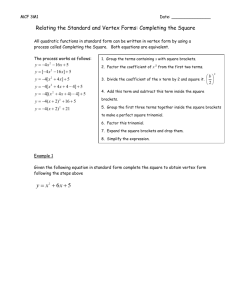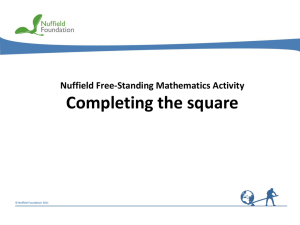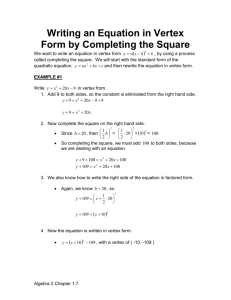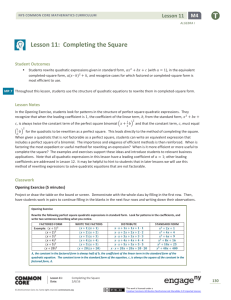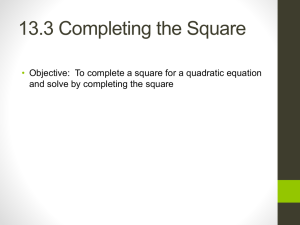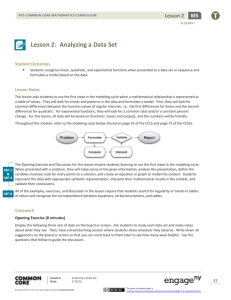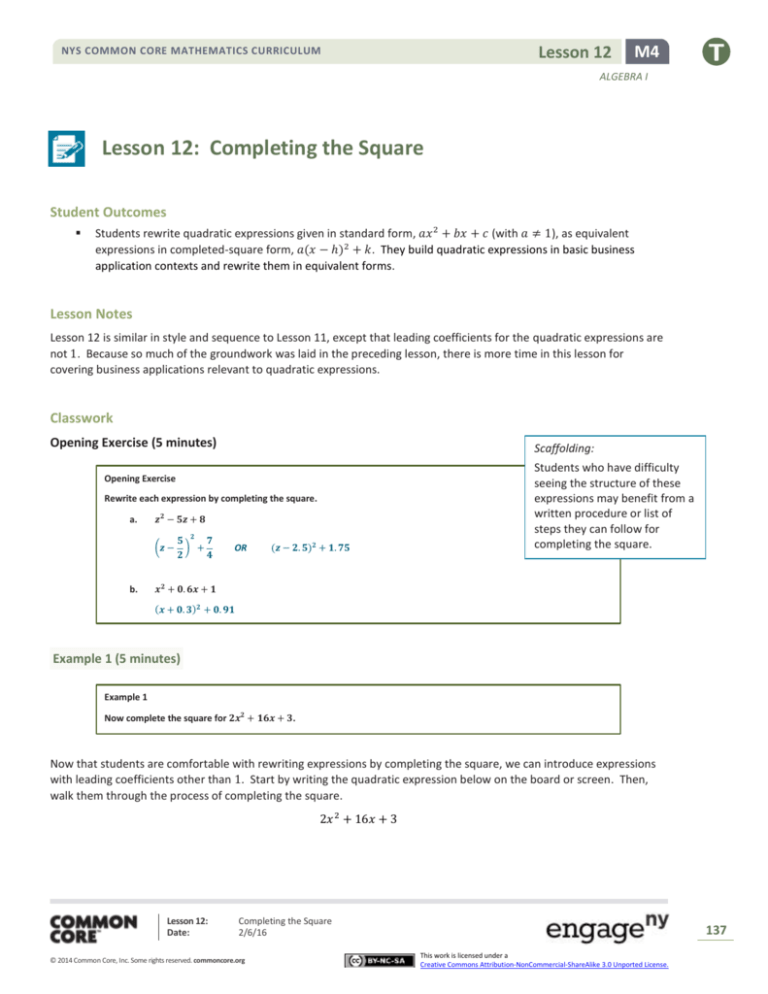
Lesson 12
NYS COMMON CORE MATHEMATICS CURRICULUM
M4
ALGEBRA I
Lesson 12: Completing the Square
Student Outcomes
Students rewrite quadratic expressions given in standard form, 𝑎𝑥 2 + 𝑏𝑥 + 𝑐 (with 𝑎 ≠ 1), as equivalent
expressions in completed-square form, 𝑎(𝑥 − ℎ)2 + 𝑘. They build quadratic expressions in basic business
application contexts and rewrite them in equivalent forms.
Lesson Notes
Lesson 12 is similar in style and sequence to Lesson 11, except that leading coefficients for the quadratic expressions are
not 1. Because so much of the groundwork was laid in the preceding lesson, there is more time in this lesson for
covering business applications relevant to quadratic expressions.
Classwork
Opening Exercise (5 minutes)
Scaffolding:
Opening Exercise
Rewrite each expression by completing the square.
a.
𝒛𝟐 − 𝟓𝒛 + 𝟖
(𝒛 −
b.
𝟓 𝟐 𝟕
) +
𝟐
𝟒
OR
(𝒛 − 𝟐. 𝟓)𝟐 + 𝟏. 𝟕𝟓
Students who have difficulty
seeing the structure of these
expressions may benefit from a
written procedure or list of
steps they can follow for
completing the square.
𝒙𝟐 + 𝟎. 𝟔𝒙 + 𝟏
(𝒙 + 𝟎. 𝟑)𝟐 + 𝟎. 𝟗𝟏
Example 1 (5 minutes)
Example 1
Now complete the square for 𝟐𝒙𝟐 + 𝟏𝟔𝒙 + 𝟑.
Now that students are comfortable with rewriting expressions by completing the square, we can introduce expressions
with leading coefficients other than 1. Start by writing the quadratic expression below on the board or screen. Then,
walk them through the process of completing the square.
2𝑥 2 + 16𝑥 + 3
Lesson 12:
Date:
Completing the Square
2/6/16
© 2014 Common Core, Inc. Some rights reserved. commoncore.org
137
This work is licensed under a
Creative Commons Attribution-NonCommercial-ShareAlike 3.0 Unported License.
Lesson 12
NYS COMMON CORE MATHEMATICS CURRICULUM
M4
ALGEBRA I
Since students already know how to complete the square when the leading coefficient is 1, one way to deal with the
leading coefficient is to group the 𝑥-terms and factor out the leading coefficient. Then, they can proceed exactly as they
did in the previous lesson. Students should be careful to pay attention to the multiplier on the outside of the
parentheses and also to the signs involved.
2(𝑥 2 + 8𝑥
)+3
Now complete the square of the quadratic expression in the parentheses, and offset the addition on the outside of the
parentheses.
2(𝑥 2 + 8𝑥 + 42 ) + 3 − 2(42 )
Make sure all agree that the two operations will reverse each other and that the new expression is equivalent to the old.
2(𝑥 + 4)2 + 3 − 32 → 2(𝑥 + 4)2 − 29
Check:
2(𝑥 + 4)2 − 29 = 2(𝑥 2 + 8𝑥 + 16) − 29 = 2𝑥 2 + 16𝑥 + 32 − 29 = 2𝑥 2 + 16𝑥 + 3
Yes, this matches our original expression.
Example 2 (15 Minutes)
If your students are not familiar with the vocabulary of business, you will need to spend some time going through the
terms and definitions below, which are also included in the student materials. Spending a few extra minutes on the
vocabulary may extend the time needed for this example but will be well worth it. After doing so, guide your students
through the example that follows. Remind them to refer to the vocabulary reference in their materials when needed.
This information will be used in future lessons in this module and may need to become part of the students’ math
journals or notebooks.
The relationship between the cost of an item and the quantity sold is often linear. Once we determine a
relationship between the selling price of an item and the quantity sold, we can think about how to generate the
most profit, i.e., at what selling price do we make the most money?
Quadratic expressions are sometimes used to model situations and relationships in business. A common
application in business is to maximize profit, that is, the difference between the total revenue (income from
sales) and the production cost. It will be important to understand the vocabulary used in business applications.
It will be a good idea to put the following information in your math notebook to use as a reference, as business
applications will be used in future lessons of this module.
Example 2
Business Application Vocabulary
UNIT PRICE (PRICE PER UNIT): The price per item a business sets to sell its product, which is sometimes represented as a
linear expression.
QUANTITY: The number of items sold, sometimes represented as a linear expression.
REVENUE: The total income based on sales (but without considering the cost of doing business).
UNIT COST (COST PER UNIT) OR PRODUCTION COST: The cost of producing one item, sometimes represented as a linear
expression.
Lesson 12:
Date:
Completing the Square
2/6/16
© 2014 Common Core, Inc. Some rights reserved. commoncore.org
138
This work is licensed under a
Creative Commons Attribution-NonCommercial-ShareAlike 3.0 Unported License.
Lesson 12
NYS COMMON CORE MATHEMATICS CURRICULUM
M4
ALGEBRA I
PROFIT: The amount of money a business makes on the sale of its product. Profit is determined by taking the total
revenue (the quantity sold multiplied by the price per unit) and subtracting the total cost to produce the items (the
quantity sold multiplied by the production cost per unit): 𝐏𝐫𝐨𝐟𝐢𝐭 = 𝐓𝐨𝐭𝐚𝐥 𝐑𝐞𝐯𝐞𝐧𝐮𝐞 − 𝐓𝐨𝐭𝐚𝐥 𝐏𝐫𝐨𝐝𝐮𝐜𝐭𝐢𝐨𝐧 𝐂𝐨𝐬𝐭𝐬.
We can integrate the linear relationship of selling price to quantity and the profit formula to create a quadratic
equation, which we can then maximize.
Use the example below to model this.
The following business formulas will be used in this and the remaining lessons in the module:
𝐓𝐨𝐭𝐚𝐥 𝐏𝐫𝐨𝐝𝐮𝐜𝐭𝐢𝐨𝐧 𝐂𝐨𝐬𝐭𝐬 = (𝐜𝐨𝐬𝐭 𝐩𝐞𝐫 𝐮𝐧𝐢𝐭)(𝐪𝐮𝐚𝐧𝐭𝐢𝐭𝐲 𝐨𝐟 𝐢𝐭𝐞𝐦𝐬 𝐬𝐨𝐥𝐝)
𝐓𝐨𝐭𝐚𝐥 𝐑𝐞𝐯𝐞𝐧𝐮𝐞 = (𝐩𝐫𝐢𝐜𝐞 𝐩𝐞𝐫 𝐮𝐧𝐢𝐭)(𝐪𝐮𝐚𝐧𝐭𝐢𝐭𝐲 𝐨𝐟 𝐢𝐭𝐞𝐦𝐬 𝐬𝐨𝐥𝐝)
𝐏𝐫𝐨𝐟𝐢𝐭 = 𝐓𝐨𝐭𝐚𝐥 𝐑𝐞𝐯𝐞𝐧𝐮𝐞 − 𝐓𝐨𝐭𝐚𝐥 𝐏𝐫𝐨𝐝𝐮𝐜𝐭𝐢𝐨𝐧 𝐂𝐨𝐬𝐭𝐬
Have students work in pairs or small groups to solve the following problem:
Now solve the following problem:
A certain business is marketing its product and has collected data on sales and prices for
the past few years. The company determined that when it raised the selling price of the
product, the number of sales went down. The cost of producing a single item is $𝟏𝟎.
a.
Using the data the company collected in this table, determine a linear
expression to represent the quantity sold, 𝒒.
𝒒 = −𝟐𝟎𝒔 + 𝟏, 𝟐𝟎𝟎
Selling
Price (𝒔)
Quantity
Sold (𝒒)
𝟏𝟎
𝟏, 𝟎𝟎𝟎
𝟏𝟓
𝟗𝟎𝟎
𝟐𝟎
𝟖𝟎𝟎
𝟐𝟓
𝟕𝟎𝟎
Use any two of the points of the data to find the slope of the linear relationship, as found in the data, to be
−𝟐𝟎. Substitute the coordinates of any (𝒔, 𝒒) ordered pair from the table into the equation 𝒒 = −𝟐𝟎𝒔 + 𝒃,
and solve for 𝒃 to find the 𝒚-intercept, which is 𝟏, 𝟐𝟎𝟎.
Or use a graphic method to find the linear equation. Plot the data on a coordinate plane with 𝒔 on the
horizontal axis and 𝒒 on the vertical axis. Use any two known points to determine the slope to be −𝟐𝟎. The
𝒚-intercept will be visible, but the student should use an algebraic method to verify rather than just
estimating from the graph. Substitute these values into slope-intercept form (𝒚 = 𝒎𝒙 + 𝒃).
Use student responses from above to derive the following steps as a class. Discuss the algebraic reasoning behind each
step, and then follow with the questions below.
Lesson 12:
Date:
Completing the Square
2/6/16
© 2014 Common Core, Inc. Some rights reserved. commoncore.org
139
This work is licensed under a
Creative Commons Attribution-NonCommercial-ShareAlike 3.0 Unported License.
Lesson 12
NYS COMMON CORE MATHEMATICS CURRICULUM
M4
ALGEBRA I
b.
Now find an expression to represent the profit function, 𝑷.
Let 𝒒 = the quantity sold, 𝒔 = the selling price, 𝑷 = total profit, and 𝑷(𝒔) = the Profit function, the profit to
be made with respect to the selling price.
𝑷 = (𝒔)(𝒒) − 𝟏𝟎𝒒
Profit formula is 𝐏 = 𝐓𝐨𝐭𝐚𝐥 𝐑𝐞𝐯𝐞𝐧𝐮𝐞 −
𝐏𝐫𝐨𝐝𝐮𝐜𝐭𝐢𝐨𝐧 𝐂𝐨𝐬𝐭𝐬
𝐓𝐨𝐭𝐚𝐥 𝐑𝐞𝐯𝐞𝐧𝐮𝐞 = 𝐩𝐫𝐢𝐜𝐞 ∙ 𝐪𝐮𝐚𝐧𝐭𝐢𝐭𝐲 𝐬𝐨𝐥𝐝
𝐏𝐫𝐨𝐝𝐮𝐜𝐭𝐢𝐨𝐧 𝐂𝐨𝐬𝐭𝐬 = 𝐜𝐨𝐬𝐭 𝐩𝐞𝐫 𝐢𝐭𝐞𝐦 ∙ 𝐪𝐮𝐚𝐧𝐭𝐢𝐭𝐲 𝐬𝐨𝐥𝐝
𝑷 = 𝒔(−𝟐𝟎𝒔 + 𝟏, 𝟐𝟎𝟎) − 𝟏𝟎(−𝟐𝟎𝒔 + 𝟏, 𝟐𝟎𝟎) Substitute −𝟐𝟎𝒔 + 𝟏, 𝟐𝟎𝟎 for 𝒒 in profit formula.
(Note that if we factor the common factor from this form
of 𝑷(𝒔), we get: 𝑷(𝒔) = (−𝟐𝟎 + 𝟏𝟐𝟎𝟎)(𝒔 − 𝟏𝟎). This
could save time later when we need to factor.)
Multiply the expressions and combine like terms. We now
𝑷(𝒔) = −𝟐𝟎𝒔𝟐 + 𝟏, 𝟐𝟎𝟎𝒔 + 𝟐𝟎𝟎𝒔 − 𝟏𝟐, 𝟎𝟎𝟎
have a quadratic function relating the price per item, 𝒔, to
Profit.
This is the expression that represents the Profit function.
𝑷(𝒔) = −𝟐𝟎𝒔𝟐 + 𝟏, 𝟒𝟎𝟎𝒔 − 𝟏𝟐, 𝟎𝟎𝟎
Find the equivalent factored form of the expression. How might we use the
factored form?
−20(𝑠 2 − 70𝑠 + 600)
−20(𝑠 − 60)(𝑠 − 10)
We can use the factored form of the expression to find the zeros of 𝑃 by
factoring and then setting the expression equal to zero.
Scaffolding:
Have students graph the
quadratic equation to visually
represent the function, 𝑃(𝑠),
and the maximum profit.
Use the zeros to find the minimum or maximum value for the profit function, 𝑃(𝑠). How might we use the
vertex to interpret the profit function? (Remind students of the process used in earlier lessons in this Module.)
If we set the expression above equal to 0, we get the following:
−20(𝑠 − 60)(𝑠 − 10) = 0, which leads to 𝑠 = 10 or 60.
Halfway between them is the axis of symmetry and the 𝑠-value for the vertex, which is 𝑠 = 35.
Then, 𝑃(35) = $12,500.
By finding the vertex, we can determine the selling price that will generate the maximum profit. The 𝑥values (domain) represent selling price, so the value of the 𝑥-coordinate at the vertex represents the
best price. The 𝑃-value at the vertex tells us the amount of profit made at the maximum.
What is the equivalent completed-square form for the profit expression?
−20𝑠 2 + 1,400𝑠 − 12,000
−20(𝑠 2 − 70𝑠 + 352 ) − 12,000 + 20(352 )
−20(𝑠 − 35)2 − 12,000 + 24,500
−20(𝑠 − 35)2 + 12,500
What do you notice about the values in the completed-square form?
By finding the vertex of the parabola, we will find the selling price that will generate the most profit.
The 𝑥-axis represents selling price, so the value of the 𝑥-coordinate at the vertex represents the best
price.
The 𝑃-value at the vertex tells us the maximum amount of profit to be made.
Hopefully, students will notice that the vertex can be seen in the parameters of the completed square form. If not, point
it out to them: (𝑥 − ℎ)2 + 𝑘, where (ℎ, 𝑘) is the vertex.
Lesson 12:
Date:
Completing the Square
2/6/16
© 2014 Common Core, Inc. Some rights reserved. commoncore.org
140
This work is licensed under a
Creative Commons Attribution-NonCommercial-ShareAlike 3.0 Unported License.
Lesson 12
NYS COMMON CORE MATHEMATICS CURRICULUM
M4
ALGEBRA I
Exercises (10 minutes)
Exercises 16 include a business application but primarily focus on the procedure for completing the square. If time is
short, you may want to choose two or three of these to work in class and assign the others along with the Problem Set.
Exercises
For Exercises 1–5, rewrite each expression by completing the square.
1.
𝟑𝒙𝟐 + 𝟏𝟐𝒙 − 𝟖
𝟑(𝒙𝟐 + 𝟒𝒙) − 𝟖 → 𝟑(𝒙 + 𝟐)𝟐 − 𝟖 − 𝟏𝟐 → 𝟑(𝒙 + 𝟐)𝟐 − 𝟐𝟎
2.
𝟒𝒑𝟐 − 𝟏𝟐𝒑 + 𝟏𝟑
𝟑 𝟐
𝟑 𝟐
𝟒(𝒑𝟐 − 𝟑𝒑) + 𝟏𝟑 → 𝟒 (𝒑 − ) + 𝟏𝟑 − 𝟗 → 𝟒 (𝒑 − ) + 𝟒
𝟐
𝟐
3.
𝟏
𝟐
𝒚𝟐 + 𝟑𝒚 − 𝟒
𝟏 𝟐
𝟏
𝟗 𝟏
𝟏𝟕
(𝒚 + 𝟔𝒚) − 𝟒 → (𝒚 + 𝟑)𝟐 − 𝟒 − → (𝒚 + 𝟑)𝟐 −
𝟐
𝟐
𝟐 𝟐
𝟐
4.
𝟏. 𝟐𝒏𝟐 − 𝟑𝒏 + 𝟔. 𝟓
𝟏. 𝟐(𝒏𝟐 − 𝟐. 𝟓𝒏) + 𝟔. 𝟓 → 𝟏. 𝟐(𝒏 − 𝟏. 𝟐𝟓)𝟐 + 𝟔. 𝟓 − 𝟏. 𝟖𝟕𝟓 → 𝟏. 𝟐(𝒏 − 𝟏. 𝟐𝟓)𝟐 + 𝟒. 𝟔𝟐𝟓
5.
𝟏
𝟑
𝒗𝟐 − 𝟒𝒗 + 𝟏𝟎
𝟏 𝟐
𝟏
𝟏
(𝒗 − 𝟏𝟐𝒗) + 𝟏𝟎 → (𝒗 − 𝟔)𝟐 + 𝟏𝟎 − 𝟏𝟐 → (𝒗 − 𝟔)𝟐 − 𝟐
𝟑
𝟑
𝟑
6.
A fast food restaurant has determined that its price function is 𝟑 −
𝒙
, where 𝒙 represents the number of
𝟐𝟎,𝟎𝟎𝟎
hamburgers sold.
a.
The cost of producing 𝒙 hamburgers is determined by the expression 𝟓, 𝟎𝟎𝟎 + 𝟎. 𝟓𝟔𝒙. Write an expression
representing the profit for selling 𝒙 hamburgers.
𝐏𝐫𝐨𝐟𝐢𝐭 = 𝐓𝐨𝐭𝐚𝐥 𝐑𝐞𝐯𝐞𝐧𝐮𝐞 − 𝐓𝐨𝐭𝐚𝐥 𝐏𝐫𝐨𝐝𝐮𝐜𝐭𝐢𝐨𝐧 𝐂𝐨𝐬𝐭𝐬 = (𝐪𝐮𝐚𝐧𝐭𝐢𝐭𝐲)(𝐩𝐫𝐢𝐜𝐞) − 𝐜𝐨𝐬𝐭
= (𝒙) (𝟑 −
𝒙
) − (𝟓, 𝟎𝟎𝟎 + 𝟎. 𝟓𝟔𝒙)
𝟐𝟎, 𝟎𝟎𝟎
𝒙𝟐
− 𝟓, 𝟎𝟎𝟎 − 𝟎. 𝟓𝟔𝒙
𝟐𝟎, 𝟎𝟎𝟎
𝟐
𝒙
=−
+ 𝟐. 𝟒𝟒𝒙 − 𝟓, 𝟎𝟎𝟎
𝟐𝟎, 𝟎𝟎𝟎
= 𝟑𝒙 −
Lesson 12:
Date:
Completing the Square
2/6/16
© 2014 Common Core, Inc. Some rights reserved. commoncore.org
141
This work is licensed under a
Creative Commons Attribution-NonCommercial-ShareAlike 3.0 Unported License.
Lesson 12
NYS COMMON CORE MATHEMATICS CURRICULUM
M4
ALGEBRA I
b.
Complete the square for your expression in part (a) to determine the number of hamburgers that need to be
sold to maximize the profit, given this price function.
−
𝟏
(𝒙𝟐 − 𝟒𝟖, 𝟖𝟎𝟎𝒙 +
𝟐𝟎, 𝟎𝟎𝟎
𝟏
𝟐𝟒, 𝟒𝟎𝟎𝟐
(𝒙𝟐 − 𝟒𝟖, 𝟖𝟎𝟎𝒙 + 𝟐𝟒, 𝟒𝟎𝟎𝟐 ) − 𝟓, 𝟎𝟎𝟎 +
𝟐𝟎, 𝟎𝟎𝟎
𝟐𝟎, 𝟎𝟎𝟎
𝟏
𝟐
(𝒙 − 𝟐𝟒, 𝟒𝟎𝟎) − 𝟓, 𝟎𝟎𝟎 + 𝟐𝟗, 𝟕𝟔𝟖
=−
𝟐𝟎, 𝟎𝟎𝟎
𝟏
(𝒙 − 𝟐𝟒, 𝟒𝟎𝟎)𝟐 + 𝟐𝟒, 𝟕𝟔𝟖
=−
𝟐𝟎, 𝟎𝟎𝟎
) − 𝟓, 𝟎𝟎𝟎 = −
So, 𝟐𝟒, 𝟒𝟎𝟎 hamburgers must be sold to maximize the profit using this price expression. Note: The profit will
be $𝟐𝟒, 𝟕𝟔𝟖.
Lesson Summary
Here is an example of completing the square of a quadratic expression of the form 𝒂𝒙𝟐 + 𝒃𝒙 + 𝒄.
𝟑𝒙𝟐 − 𝟏𝟖𝒙 − 𝟐
𝟑(𝒙𝟐 − 𝟔𝒙) − 𝟐
𝟑(𝒙𝟐 − 𝟔𝒙 + 𝟗) − 𝟑(𝟗) − 𝟐
𝟑(𝒙 − 𝟑)𝟐 − 𝟑(𝟗) − 𝟐
𝟑(𝒙 − 𝟑)𝟐 − 𝟐𝟗
1.
2.
Exit Ticket (10 minutes)
Lesson 12:
Date:
Completing the Square
2/6/16
© 2014 Common Core, Inc. Some rights reserved. commoncore.org
142
This work is licensed under a
Creative Commons Attribution-NonCommercial-ShareAlike 3.0 Unported License.
Lesson 12
NYS COMMON CORE MATHEMATICS CURRICULUM
M4
ALGEBRA I
Name ___________________________________________________
Date____________________
Lesson 12: Completing the Square
Exit Ticket
1.
Complete the square: 𝑎𝑥 2 + 𝑥 + 3.
2.
Write the expression for the profit, 𝑃, in terms of 𝑞, the quantity sold, and 𝑠, the selling price, based on the data
collected below on sales and prices. Use the examples and your notes from class to then determine the function
that represents yearly profit, 𝑃, in terms of the sales, 𝑠, given the production cost per item is $30.
Lesson 12:
Date:
Selling Price, $ (𝒔)
Quantity Sold (𝒒)
100
200
500
7,000
6,000
3,000
600
800
2,000
0
Completing the Square
2/6/16
© 2014 Common Core, Inc. Some rights reserved. commoncore.org
143
This work is licensed under a
Creative Commons Attribution-NonCommercial-ShareAlike 3.0 Unported License.
Lesson 12
NYS COMMON CORE MATHEMATICS CURRICULUM
M4
ALGEBRA I
Exit Ticket Sample Solutions
Complete the square: 𝒂𝒙𝟐 + 𝒙 + 𝟑.
𝟏
𝟏 𝟐
𝟏
𝒂 (𝒙𝟐 + 𝒙) + 𝟑 → 𝒂 (𝒙 + ) + 𝟑 −
𝒂
𝟐𝒂
𝟒𝒂
Write the expression for the profit, 𝑷, in terms of 𝒒, the quantity sold, and 𝒔, the selling price, based on the data
collected below on sales and prices. Use the examples and your notes from class to then determine the function
that represents yearly profit, 𝑷, in terms of the sales, 𝒔, given the production cost per item is $𝟑𝟎.
Selling Price, $ (𝒔)
Quantity Sold (𝒒)
𝟏𝟎𝟎
𝟐𝟎𝟎
𝟓𝟎𝟎
𝟔𝟎𝟎
𝟖𝟎𝟎
𝟕, 𝟎𝟎𝟎
𝟔, 𝟎𝟎𝟎
𝟑, 𝟎𝟎𝟎
𝟐, 𝟎𝟎𝟎
𝟎
The Revenue (total income from sales) is the price per item times number of items, (𝒔)(𝒒), and the cost is 𝟑𝟎𝒒, so
the profit is 𝑷 = (𝒔)(𝒒) − 𝟑𝟎𝒒.
The graph showing the relationship between 𝒔 and 𝒒 is a line with slope −𝟏𝟎 and 𝒒-intercept 𝟖, 𝟎𝟎𝟎, so
𝒒 = −𝟏𝟎𝒔 + 𝟖, 𝟎𝟎𝟎.
This means the Profit function is 𝑷(𝒔) = 𝒔(−𝟏𝟎𝒔 + 𝟖, 𝟎𝟎𝟎) − 𝟑𝟎(−𝟏𝟎𝒔 + 𝟖, 𝟎𝟎𝟎).
Factoring the common factors out gives us 𝑷(𝒔) = (−𝟏𝟎𝒔 + 𝟖, 𝟎𝟎𝟎)(𝒔 − 𝟑𝟎) = −𝟏𝟎(𝒔 − 𝟖𝟎𝟎)(𝒔 − 𝟑𝟎).
Or, multiplying and combining like terms gives us 𝑷(𝒔) = −𝟏𝟎𝒔𝟐 + 𝟖, 𝟑𝟎𝟎𝒔 − 𝟐𝟒𝟎, 𝟎𝟎𝟎.
Solution Notes:
1.
Some students may give the answer as 𝑞 = −10𝑠 + 8,000, which is an important part of finding the profit but is not
complete. The revenue (total income from sales) is the product (𝑠)(𝑞), and the cost is 30𝑞, so the profit is
𝑃 = (𝑠)(𝑞) − 30𝑞. Using the equation for 𝑞: 𝑃 = 𝑠(−10𝑠 + 8,000) − 30(−10𝑠 + 8,000). Multiplying and
combining like terms gives 𝑃 = −10𝑠 2 + 8,300𝑠 − 240,000.
2.
Students may also come up with 𝑃 = (𝑠)(𝑞) − 30𝑞. While it is true that 𝑃 = (𝑠)(𝑞) − 30𝑞, this expression has two
variables. 𝑞 needs to be substituted for its equivalent in terms of 𝑠 so that the function 𝑃(𝑠) is written in terms of 𝑠.
3.
The graph showing the relationship between 𝑞 and 𝑠 is a line with slope −10 and 𝑞-intercept 8,000, so
𝑞 = −10𝑠 + 8,000. This means 𝑃 = 𝑠(−10𝑠 + 8,000) − 30(−10𝑠 + 8,000). Multiplying and simplifying gives
𝑃 = −10𝑠 2 + 8,300𝑠 − 240,000.
Lesson 12:
Date:
Completing the Square
2/6/16
© 2014 Common Core, Inc. Some rights reserved. commoncore.org
144
This work is licensed under a
Creative Commons Attribution-NonCommercial-ShareAlike 3.0 Unported License.
Lesson 12
NYS COMMON CORE MATHEMATICS CURRICULUM
M4
ALGEBRA I
Problem Set Sample Solutions
Rewrite each expression by completing the square.
1.
−𝟐𝒙𝟐 + 𝟖𝒙 + 𝟓
−𝟐(𝒙𝟐 − 𝟒𝒙 + 𝟒) + 𝟓 + 𝟖 → −𝟐(𝒙 − 𝟐)𝟐 + 𝟏𝟑
2.
𝟐. 𝟓𝒌𝟐 − 𝟕. 𝟓𝒌 + 𝟏. 𝟐𝟓
𝟐. 𝟓(𝒌𝟐 − 𝟑𝒌 + 𝟐. 𝟐𝟓) + 𝟏. 𝟐𝟓 − 𝟓. 𝟔𝟐𝟓 → 𝟐. 𝟓(𝒌 − 𝟏. 𝟓)𝟐 − 𝟒. 𝟑𝟕𝟓
3.
𝟒
𝟑
𝒃𝟐 + 𝟔𝒃 − 𝟓
𝟒 𝟐 𝟗
𝟖𝟏
𝟐𝟕 𝟒
𝟗 𝟐 𝟒𝟕
(𝒃 + 𝒃 + ) − 𝟓 −
→ (𝒃 + ) −
𝟑
𝟐
𝟏𝟔
𝟒
𝟑
𝟒
𝟒
4.
𝟏, 𝟎𝟎𝟎𝒄𝟐 − 𝟏, 𝟐𝟓𝟎𝒄 + 𝟔𝟗𝟓
𝟏, 𝟎𝟎𝟎(𝒄𝟐 − 𝟏. 𝟐𝟓𝒄 + 𝟎. 𝟔𝟐𝟓𝟐 ) + 𝟔𝟗𝟓 − 𝟑𝟗𝟎. 𝟔𝟐𝟓 → 𝟏, 𝟎𝟎𝟎(𝒄 − 𝟎. 𝟔𝟐𝟓)𝟐 + 𝟑𝟎𝟒. 𝟑𝟕𝟓
5.
𝟖𝒏𝟐 + 𝟐𝒏 + 𝟓
𝟏
𝟏
𝟏
𝟏 𝟐
𝟕
𝟖 (𝒏𝟐 + 𝒏 + ) + 𝟓 − → 𝟖 (𝒏 + ) + 𝟒
𝟒
𝟔𝟒
𝟖
𝟖
𝟖
Lesson 12:
Date:
Completing the Square
2/6/16
© 2014 Common Core, Inc. Some rights reserved. commoncore.org
145
This work is licensed under a
Creative Commons Attribution-NonCommercial-ShareAlike 3.0 Unported License.


